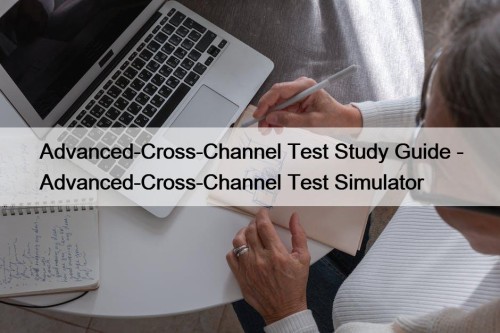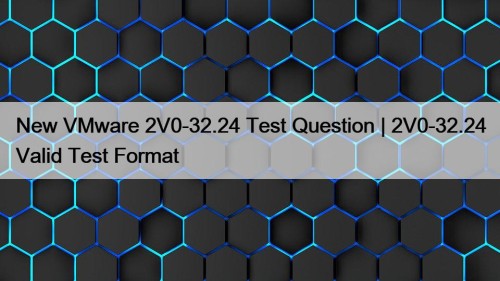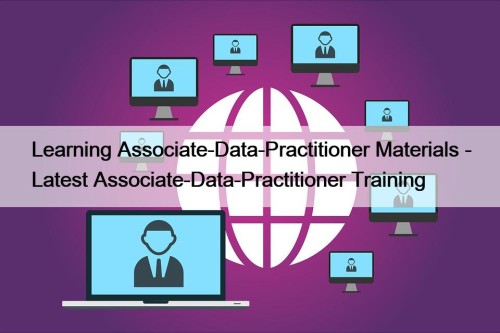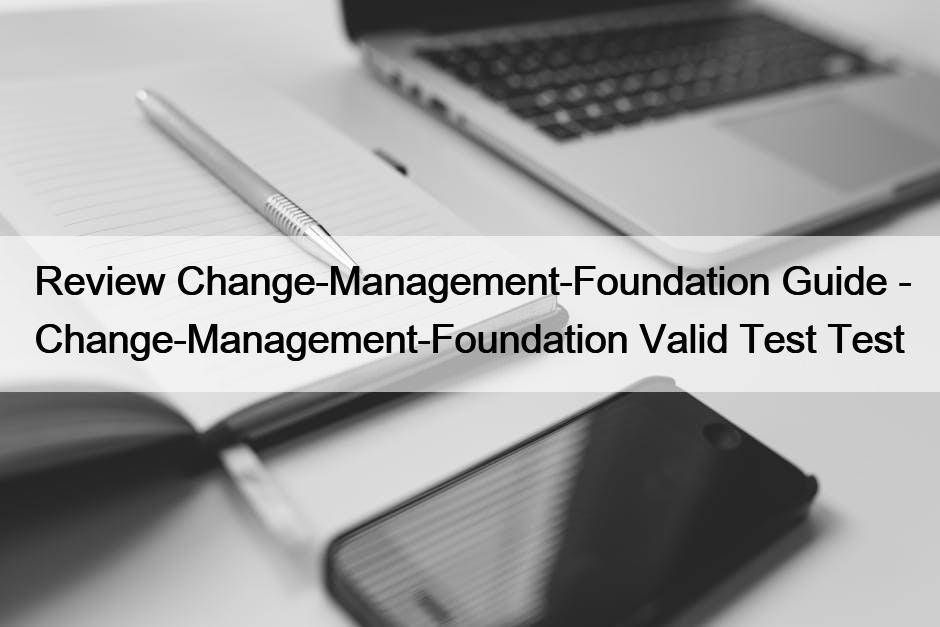Most Popular
 Advanced-Cross-Channel Test Study Guide - Advanced-Cross-Channel Test Simulator
Advanced-Cross-Channel Test Study Guide - Advanced-Cross-Channel Test Simulator
P.S. Free & New Advanced-Cross-Channel dumps are available on Google ...
 New VMware 2V0-32.24 Test Question | 2V0-32.24 Valid Test Format
New VMware 2V0-32.24 Test Question | 2V0-32.24 Valid Test Format
Would you like to register VMware 2V0-32.24 certification test? Would ...
 Learning Associate-Data-Practitioner Materials - Latest Associate-Data-Practitioner Training
Learning Associate-Data-Practitioner Materials - Latest Associate-Data-Practitioner Training
To stay updated and competitive in the market you have ...



Review Change-Management-Foundation Guide - Change-Management-Foundation Valid Test Test

This is your right to have money-back guarantee, namely once but a full refund with the transcript. Some people worry about the complex refund of our Change-Management-Foundation exam practice, as a matter of fact, our refunding procedures are very simple. We will immediately refund if the buyer provide failure test proof just like failure score scan or screenshots. If you have any questions about our Change-Management-Foundation Preparation quiz, please contact us by online service or email, we will reply as soon as possible.
APMG-International Change-Management-Foundation Exam Syllabus Topics:
| Topic | Details |
|---|---|
| Topic 1 |
|
| Topic 2 |
|
| Topic 3 |
|
| Topic 4 |
|
| Topic 5 |
|
| Topic 6 |
|
| Topic 7 |
|
>> Review Change-Management-Foundation Guide <<
Change-Management-Foundation Valid Test Test | Valid Change-Management-Foundation Exam Tips
We provide our customers with the most reliable learning materials about Change-Management-Foundation certification exam and the guarantee of pass. We assist you to prepare the key knowledge points of Change-Management-Foundation actual test and obtain the up-to-dated exam answers. All Change-Management-Foundation Test Questions offered by us are tested and selected by our senior experts in IT filed, which only need little time to focus on the practice and the preparation.
APMG-International Change Management Foundation Exam Sample Questions (Q11-Q16):
NEW QUESTION # 11
How does change management contribute to benefits?
- A. Encourages users to make the best use of the new situation
- B. Produces all of the outcomes required to deliver benefits
- C. Provides ultimate accountability for the benefits of a change
- D. Ensures dis-benefits are avoided
Answer: A
Explanation:
Comprehensive and Detailed In-Depth Explanation:
Change management's role in benefits realization is a critical theme in the APMG Change Management Foundation, focusing on enabling people to adopt and optimize change. Let's explore each option in depth:
*Option A: "Encourages users to make the best use of the new situation" - This is correct. Change management ensures benefits by preparing, supporting, and motivating people to embrace and maximize the change. For example, training staff on a new CRM system ensures they use its features effectively, driving benefits like increased sales. The framework defines this as change management's primary contribution:
aligning human behavior with intended outcomes.
*Option B: "Ensures dis-benefits are avoided" - While change management mitigates risks (e.g., resistance), avoiding dis-benefits entirely is not its core focus or guarantee. This is more a project management responsibility, making this incorrect.
*Option C: "Provides ultimate accountability for the benefits of a change" - Accountability lies with sponsors or business owners, not change management, which supports rather than owns benefits realization. This is false per the APMG roles delineation.
*Option D: "Produces all of the outcomes required to deliver benefits" - Change management influences adoption but doesn't produce all outcomes (e.g., technical delivery), which involves other disciplines. This overstates its scope.
Option A aligns with the APMG emphasis on adoption and utilization as the bridge between change delivery and benefits, making it the most accurate answer.
NEW QUESTION # 12
According to Tuckman, in what stage of the team development model will members of the team be working collectively to achieve results?
- A. Storming
- B. Adjourning
- C. Forming
- D. Performing
Answer: D
Explanation:
Comprehensive and Detailed In-Depth Explanation:
Performing is when Tuckman's team collaborates effectively to deliver results, post-conflict resolution. It's the productive stage, per APMG.
NEW QUESTION # 13
According to theBechard and Harris change formula' which response will increase an individual's dissatisfaction with the status quo?
- A. Clarify the steps users need to take
- B. Amend performance targets during the change
- C. Focus on the benefits of the change
- D. Communicate the danger of inaction
Answer: D
Explanation:
Explanation
The Beckhard and Harris change formula is a tool to assess the readiness and motivation for change in an organization. The formula states that change will happen when D x V x F > R, where D is dissatisfaction with the status quo, V is vision of the desired future state, F is first steps or action plan for the change, and R is resistance to change. To increase an individual's dissatisfaction with the status quo, one possible action is to communicate the danger of inaction, such as the risks, threats, or losses that may occur if no change is made.
This can create a sense of urgency and need for change among the individual. The other options are not actions that will increase dissatisfaction with the status quo, but rather actions that will address other factors in the formula.
NEW QUESTION # 14
Which reason explains why it is helpful to segment stakeholders?
- A. Helps identify the organization's culture for scoping appropriate engagement
- B. It highlights the level of influence and interest stakeholders have in the planned change
- C. Enables different approaches and analysis techniques to be used with different stakeholder groups
- D. Identities individuals or groups who are resisting change
Answer: C
Explanation:
Segmenting stakeholders is the process of dividing them into groups based on common characteristics, such as roles, interests, needs, expectations, or attitudes towards the change. One reason why it is helpful to segment stakeholders is that it enables different approaches and analysis techniques to be used with different stakeholder groups. For example, segmenting stakeholders can help to tailor communication messages and channels to suit each group's preferences and concerns, or to apply different engagement strategies and tactics to address each group's level of influence and impact.
NEW QUESTION # 15
Which management approach is recommended to help people through the neutral zone' phase of Gridges' model of human transition?
- A. Describe this period as an opportunity to learn
- B. Direct feedback through the normal line management processes
- C. Reduce gossip by limiting social occasions at work.
- D. Hold on to established routines wherever possible
Answer: B
Explanation:
Bridges' model of human transition describes three phases that people go through when they experience change: ending, losing, and letting go; the neutral zone; and the new beginning. The neutral zone is a period of uncertainty, confusion, and anxiety, but also creativity, innovation, and learning. To help people through this phase, change leaders should describe this period as an opportunity to learn new skills, explore new possibilities, and experiment with new solutions. The other options would not help people through this phase, as they would either maintain the status quo, increase gossip and rumors, or limit feedback channels.
References: https://apmg-international.com/sites/default/files/Change%20Management%20Foundation%
20Sample%20Paper%2010%20-%20v1.0.pdf (page 11)
NEW QUESTION # 16
......
TroytecDumps also offers APMG-International Change-Management-Foundation desktop practice exam software which is accessible without any internet connection after the verification of the required license. This software is very beneficial for all those applicants who want to prepare in a scenario which is similar to the Change Management Foundation Exam real examination. Practicing under these situations helps to kill Change Management Foundation Exam (Change-Management-Foundation) exam anxiety.
Change-Management-Foundation Valid Test Test: https://www.troytecdumps.com/Change-Management-Foundation-troytec-exam-dumps.html
- Latest Change-Management-Foundation Test Prep 📀 Latest Change-Management-Foundation Test Preparation ⚒ Pass Leader Change-Management-Foundation Dumps 🧐 Search for ▷ Change-Management-Foundation ◁ and obtain a free download on ➡ www.exam4pdf.com ️⬅️ 👠Change-Management-Foundation Pdf Demo Download
- Change-Management-Foundation Lab Questions 🤗 High Change-Management-Foundation Quality 🥝 Change-Management-Foundation New Study Plan 🐑 Easily obtain ➽ Change-Management-Foundation 🢪 for free download through ☀ www.pdfvce.com ️☀️ 🍎Change-Management-Foundation Braindump Free
- Latest Change-Management-Foundation Test Prep 🍎 Reliable Change-Management-Foundation Test Questions 🧽 Change-Management-Foundation Lab Questions 🖱 Easily obtain free download of ✔ Change-Management-Foundation ️✔️ by searching on ➥ www.examdiscuss.com 🡄 🥪Change-Management-Foundation Dumps Cost
- 2025 Professional Change-Management-Foundation: Review Change Management Foundation Exam Guide 😃 Search for “ Change-Management-Foundation ” on ⮆ www.pdfvce.com ⮄ immediately to obtain a free download 🦺Valid Change-Management-Foundation Test Forum
- Change Management Foundation Exam latest study torrent - Change-Management-Foundation advanced testing engine - Change Management Foundation Exam valid exam dumps 🗽 《 www.lead1pass.com 》 is best website to obtain ✔ Change-Management-Foundation ️✔️ for free download 🛅High Change-Management-Foundation Quality
- Change-Management-Foundation Pass Test 🏦 Valid Change-Management-Foundation Test Forum 🕺 Latest Change-Management-Foundation Test Preparation 🤠 Search on ➠ www.pdfvce.com 🠰 for 【 Change-Management-Foundation 】 to obtain exam materials for free download 👺Change-Management-Foundation New Study Plan
- Pass Guaranteed Quiz 2025 Change-Management-Foundation: Change Management Foundation Exam Unparalleled Review Guide 🔰 Open website ⇛ www.torrentvce.com ⇚ and search for 【 Change-Management-Foundation 】 for free download 🍖Reliable Change-Management-Foundation Test Questions
- Absolute Your Exam Preparation With APMG-International Change-Management-Foundation Dumps 🐊 Easily obtain ➽ Change-Management-Foundation 🢪 for free download through ➥ www.pdfvce.com 🡄 🦎Latest Change-Management-Foundation Test Prep
- APMG-International Change-Management-Foundation Exam Dumps Fastest Way Of Preparation 2025 📐 Copy URL ⮆ www.torrentvalid.com ⮄ open and search for ▶ Change-Management-Foundation ◀ to download for free 🤨High Change-Management-Foundation Quality
- Latest Change-Management-Foundation Test Preparation 🥩 Latest Change-Management-Foundation Dumps Questions ❤️ Change-Management-Foundation Pass Test 🏂 Go to website ➽ www.pdfvce.com 🢪 open and search for ✔ Change-Management-Foundation ️✔️ to download for free 🚟Valid Change-Management-Foundation Exam Pass4sure
- Latest Change-Management-Foundation Dumps Questions 💌 Pass Change-Management-Foundation Rate 🙎 Change-Management-Foundation New Study Plan 🌴 Easily obtain ➠ Change-Management-Foundation 🠰 for free download through [ www.testkingpdf.com ] 🍧Change-Management-Foundation Dumps Cost
- Change-Management-Foundation Exam Questions
- bobbydsauctions.buzzzbooster.com bloomingcareerss.com nagyelghiety.com hhy.lsh6668.com aadhyaaskills.com www.excelentaapulum.ro tomohak.net kaliorg.com devadigitalexpert.online marutidigilectures.online
Tags: Review Change-Management-Foundation Guide, Change-Management-Foundation Valid Test Test, Valid Change-Management-Foundation Exam Tips, Change-Management-Foundation Real Testing Environment, Change-Management-Foundation Certification Torrent